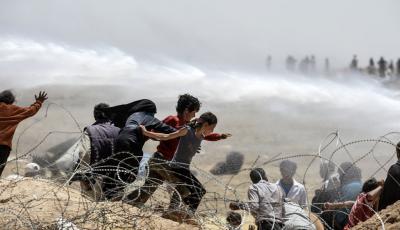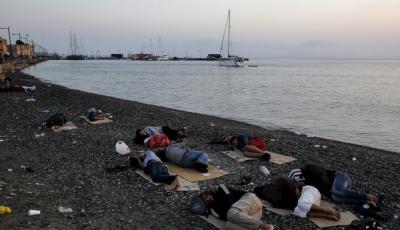Guest post by Thomas Spijkerboer, Professor of Migration Law at Vrije Universiteit Amsterdam. Thomas is currently conducting research on migrant deaths on the Mediterranean. He’s on Twitter @ThomasS_VU.
A perfect storm is a disastrous event which happens because a number of problems occur simultaneously. The interaction of different elements reinforces these problems. Europe’s migration crisis is such a perfect storm. Here are the elements.
- Major refugee crisis: Since 2011, a conflict has developed in Syria which has forced half of the population to flee: 7.5 million refugees within Syria, 4 million outside Syria (635,000 in Jordan, or some 8% out of 8 million inhabitants, 1 million in Lebanon, or some 17% out of 5.8 million inhabitants, and 2.5 million in Turkey, or some 3% out of 77.6 million inhabitants). These conservative estimates concern registered refugees; the actual number of refugees is much higher. Syria had an estimated 23 million inhabitants before the war. Much can be said to relativize these estimates, but they dwarf the estimated one to 1.5 million asylum seekers in Europe in 2015, constituting 0.2% of the EU’s 508 million inhabitants.
- Serious under-funding: Funding for hosting Syrian refugees in the region is seriously under-funded. The United Nations Office for the Coordination of Humanitarian Assistance reported that for 2015, 56% of the required funding had been received. The World Food Programme reports that critical funding shortages forced the organization to reduce the level of assistance, with most refuges now living on 50 cents a day. The EU has recently agreed on how to fund the €3 billion promised to Turkey, but when actual payments will be made remains to be seen. In addition, Turkey is not the country where the humanitarian disaster is worst.
- Minimal resettlement: Resettlement of Syrian refugees in other parts of the world―crucial in order to enable especially Lebanon to host Syrian refugees―is not occurring on a scale of any significance. Since the beginning of the conflict, only 162,151 Syrian refugees have been resettled elsewhere in the world―4% of the 4 million Syrian refugees outside Syria, and merely 2% of all Syrian refugees.
- Prohibition of travel: States have prohibited Syrians to travel, this making it impossible for them to leave Syria or the overburdened refugee camps in the region. Responding to European pressure, countries which did not require visa from Syrians in 2011 have introduced them. Crucially, Lebanon and Jordan now require Syrians to have a visa, while Turkey has introduced a visa requirement for Syrians who seek to enter via third countries such as Lebanon, although Turkish government newspapers suggest that Syrians entering the country directly from Syria will not be required to have visas. Enforcement of these visa requirements is ensured by obliging airlines to check travel documents before departure, under threat of significant fines. The external borders of the EU have been militarized, and the EU is intensifying its criminal law approach to irregular migration. UN Security Council Resolution 2240, adopted in October 2015, considers irregular migration to be a threat to international security and empowers the EU to take military action.
- Intended ripple effect: By prohibiting refugees from entering the EU and encouraging neighbouring countries to prohibit refugees entering their countries, the European Union has intentionally made it illegal and therefore very difficult for many Syrian refugees to leave their own country in order to seek the protection they need and to which they are entitled. In January, it was reported that 16,000 Syrian refugees are stranded in the desert because Jordan blocks entry. This weekend, Turkey closed its border for the estimated 70,000 refugees fleeing Aleppo.
- Common European Asylum System fails: The European Union has a set of directives and regulations which together are called the Common European Asylum System (CEAS). The aim of the CEAS is to harmonize asylum law in the EU. However, in any respect the standards vary dramatically from state to state. The quality of asylum procedures ranges from near perfect to non-existent. In some countries refugees have to live on the streets for years, whereas in others they get shelter. Some countries recognize almost no one as a refugee, while in other countries two thirds of all asylum seekers get asylum. And in some countries refugees are maltreated by authorities on a large scale, while in others that happens only incidentally. European asylum law has little in common, and there is no system to it. As a consequence, refugees have very high stakes in being in countries like Germany and Sweden, and not in countries such as Greece.
- Systematic underestimation: The Syrian conflict has been building up for a couple of years now, and refugees started to leave the country in significant numbers in 2012. The major under-funding and the lack of meaningful resettlement ensured that Syrian refugees would feel forced to try to reach Europe after a while. No fortune telling was required to predict that the combination of millions of refugees and them being neglected by the international community would lead to a movement towards Europe. Nevertheless, European authorities were taken by surprise when this happened in 2015. The lack of preparation―not enough reception facilities, insufficient immigration officers, et.―created the idea that the numbers are more than the EU can handle.
- Exploitation of problems: By now, almost every European country has prominent politicians successfully profiteering from the problems that, obviously, accompany an influx of refugees. Mainstream parties mimic their xenophobic rhetoric, and thereby undermine support for sheltering refugees.

It is the interaction between eight elements mentioned above that has created the perfect storm now raging over Europe. Can anything be done? It should be noted that the elements 2 to 7 are of Europe’s own making. It’s probably too late now to put in place a more robust system of reception in the region. The cycle of supply and demand for smuggling services and the lack of trust of Syrian refugees in the international community cannot be changed soon. But the other elements can be influenced in the short run. The market for smuggling can be disrupted by large scale resettlement, and by partially or entirely liberalizing travel for Syrian nationals, preferably together with the world’s other wealthiest nations. People recognized as refugees in Europe could be given a version of the right of free movement in the EU, facilitating them to find employment or enjoy the support of their families or ethnic communities. Underestimating the number of asylum seekers is something that states simply can stop doing.

It is more likely that European policy makers will go on fuelling the storm, led by the proposals the Commission and the Council, in cooperation with the UN, are tabling. Is it possible that the storm gets worse? Certainly. If Lebanon is not assisted immediately in shouldering the burden of the Syrian refugees―in addition to the Palestinians who have been there for over half a century! ―it’s quite possible that the civil war which ravaged the country between 1975 and 1990 will be reignited. This can lead to millions more refugees. And if European countries keep reinforcing their criminal approach to the travel of refugees and migrants, human smuggling is likely to be incorporated in the more organized drug trafficking business―a phenomenon that has occurred at the US-Mexico border and has attracted extremely well organized and ruthless entrepreneurs to the human smuggling business.
Any comments about this post? Get in touch with us! Send us an email, or post a comment here or on Facebook. You can also tweet us.
__________
How to cite this blog post (Harvard style):
Spijkerboer, T. (2016) Europe’s Refugee Crisis: A Perfect Storm. Available at: https://www.law.ox.ac.uk/research-subject-groups/centre-criminology/centreborder-criminologies/blog/2016/02/europe’s-refugee (Accessed [date]).
Share:








